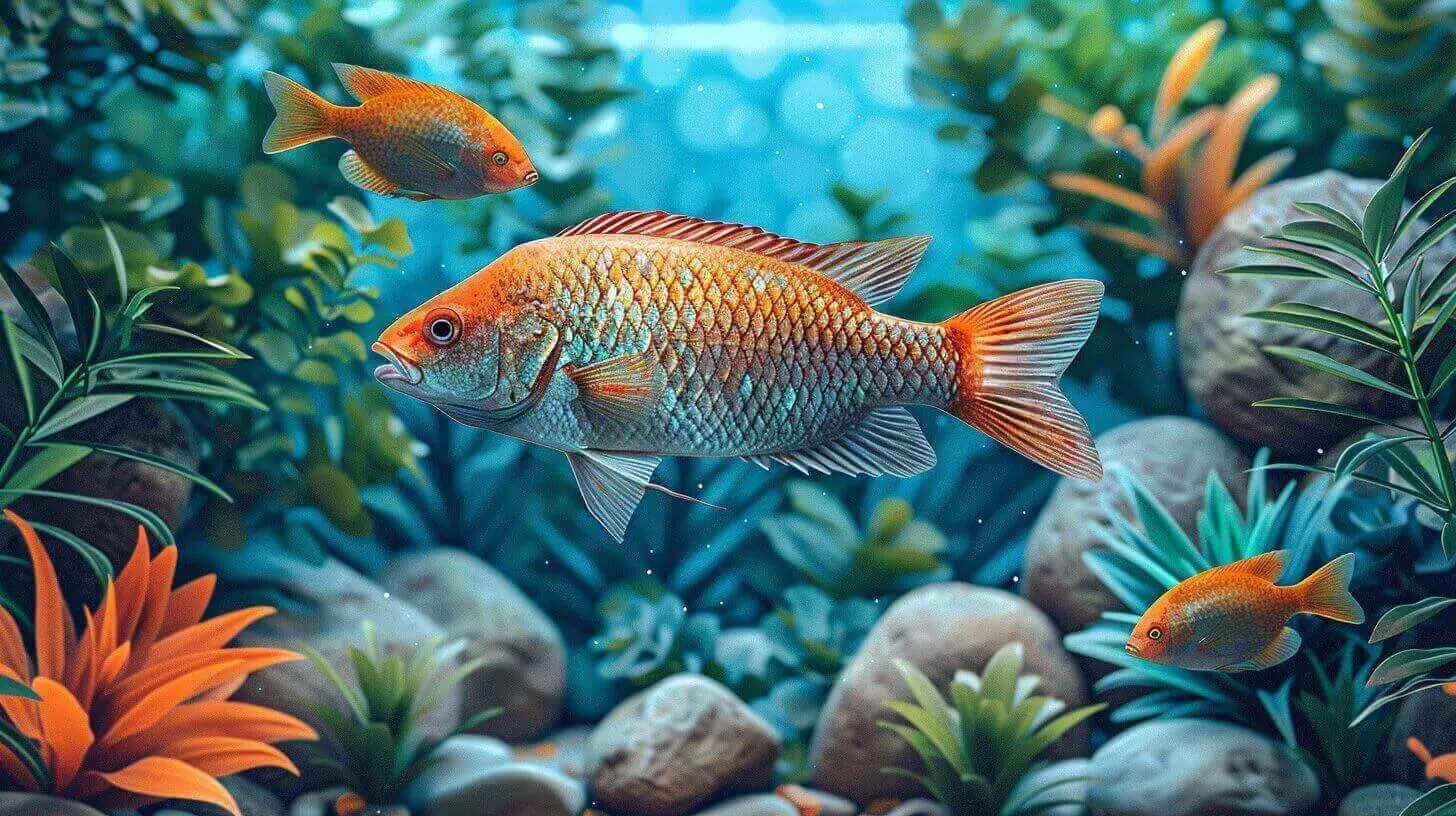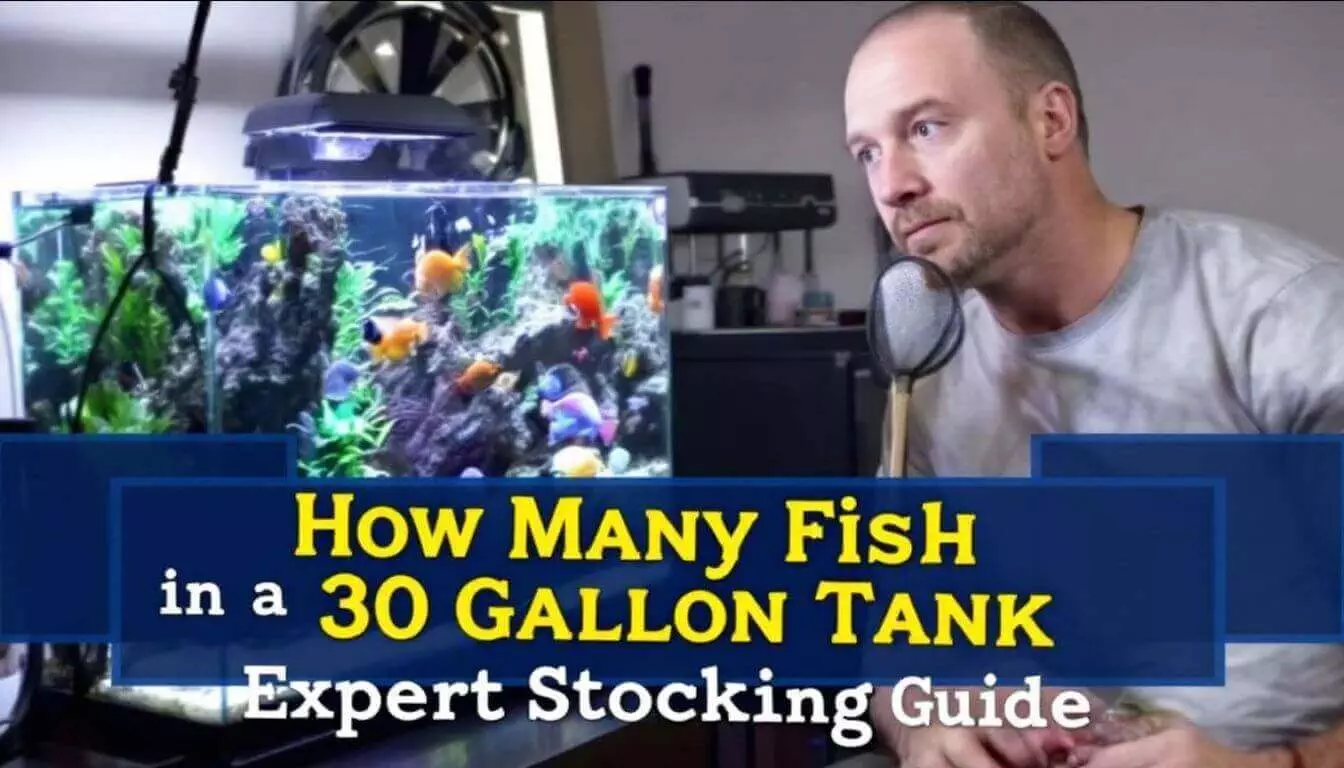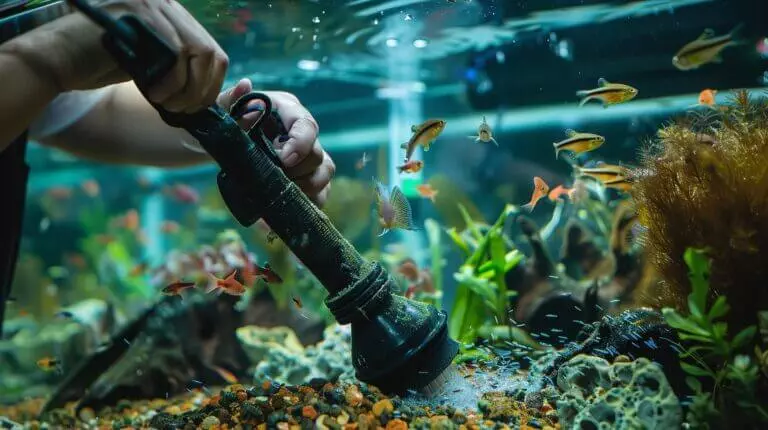Setting up a 30-gallon tank can be tricky. You might wonder how man fish in a 30-gallon tank should you put. The answer isn’t simple. Generally, it depends on fish size, species, and tank setup. A common mistake is overcrowding, which can harm your fish.
As an experienced aquarist, I’ve seen the ups and downs of tank management. I’ve dealt with water balance issues, fish conflicts, and equipment problems. This guide combines my hands-on knowledge with solid research.
You’ll learn how to stock your 30-gallon tank right. Ready to build your perfect underwater world?
Key Takeaways
- A 30-gallon tank can hold 10-15 small fish or 5-7 medium-sized fish.
- Add fish slowly over 2-3 months to keep the tank healthy.
- Pick fish that get along and need the same water conditions.
- Test water often and change 25% weekly to keep it clean.
- Research fish sizes and behaviors before buying to avoid problems later.
Understanding the Basics of a 30 Gallon Fish Tank

A 30-gallon tank is a great size for many fish. It’s big enough for some cool fish but small enough to fit in most homes. 1
Ideal Water Conditions for a 30 Gallon Aquarium
Ideal water conditions in a 30-gallon aquarium start with proper filtration. A good filter removes waste and keeps water clean. It also helps grow helpful bacteria. These tiny organisms break down harmful chemicals in the tank.
Water quality is key for fish health. Test your water often to check pH, ammonia, and nitrite levels. Keep these in the right range for your fish. Use a heater to maintain a steady temperature.
Most fish such as betta like water between 75°F to 80°F. 2 Clean water and the right temp will help your fish thrive. Next, let’s look at freshwater vs. saltwater options for your 30-gallon tank.
Good water quality is the foundation of a healthy aquarium. – Experienced Aquarist
Freshwater vs. Saltwater: Which is Best for Your 30 Gallon Tank?
Freshwater tanks offer an easier start for new fish keepers. They need less work and cost less money. You can keep many fun fish in a freshwater tank. Saltwater tanks let you have more colorful fish. But they need more care and special tools. 3 You must watch the water closely in a saltwater tank.
Your choice depends on your goals and time. Freshwater tanks suit busy people or those on a budget. Saltwater tanks excite folks who want rare fish and don’t mind extra work. Both types need you to learn about the nitrogen cycle.
This helps keep your fish healthy. Next, let’s look at what you need to set up your 30-gallon tank.
Essential Equipment for Setting Up a 30 Gallon Fish Tank
Now that you’ve chosen between freshwater and saltwater, let’s gear up your tank. You’ll need key items to create a thriving home for your fish. Here’s what to get:
- Filter: A powerful filter keeps water clean. Pick one that cycles 3-4 times the tank volume per hour.
- Heater: Maintain steady temps with a 100-watt heater. Place it near water flow for even heat.
- Lighting: LED lights support plant growth and showcase fish colors. Choose adjustable brightness for day/night cycles.
- Substrate: Add 1 to 2 inches of gravel or sand. This base anchors plants and houses good bacteria.
- Thermometer: Check water temp daily. Stick-on or digital types work well.
- Test Kit: Monitor pH, ammonia, nitrite, and nitrate levels. Weekly tests help prevent issues.
- Air Pump: Boost oxygen levels with an air stone. This helps fish breathe easier.
- Decor: Add caves, plants, and rocks. These give fish hiding spots and reduce stress.
- Fish Net: Use a soft net for catching fish during water changes or moves.
- Bucket: Get a clean 5-gallon bucket for water changes. Never use soap in it.
How Many Fish in a 30 Gallon Tank: Stocking Guidelines

Stocking a 30-gallon tank needs care. You must balance fish count with tank size for a healthy aquarium.
The One-Inch-Per-Gallon Rule: Is it Reliable?
The one-inch-per-gallon rule isn’t always reliable for stocking a 30-gallon tank. This old guideline suggests one inch of fish per gallon of water. But it fails to account for fish shape, activity level, and waste production. A better approach considers the adult size of fish, their bioload, and tank setup.
Successful aquarium stocking requires more than simple math.
For a 30-gallon tank, aim for 10 to 15 small fish or 5 to 7 medium-sized fish. Factors like filtration, plants, and regular maintenance affect your tank’s capacity. Always research each species’ needs before adding them to your aquarium. This ensures a healthy, balanced ecosystem for your aquatic pets.
Factors Affecting Fish Capacity in a 30 Gallon Tank
Moving beyond the one-inch rule, several factors impact fish capacity in a 30-gallon tank. Water quality tops the list. Good filtration keeps ammonia levels low, allowing for more fish. 4
Fish species matter too. Some need more space than others. For example, cichlids require larger territories than tetras. Aquatic plants play a role by providing oxygen and hiding spots.
They can increase the number of fish your tank supports. Beneficial bacteria balance is crucial. These tiny helpers break down waste, keeping your water clean. With proper care, you can create a thriving home for your aquatic friends.
Recommended Fish Count for Different Types of 30 Gallon Setups
Your 30-gallon tank can house different fish types based on your setup. Here’s a guide to help you stock your aquarium:
| Setup Type | Recommended Fish Count | Example Species |
|---|---|---|
| Community Freshwater | 15-20 small fish | Tetras, Guppies, Corydoras |
| Semi-Aggressive Freshwater | 5-7 medium-sized fish | Gouramis, Barbs, Rainbow Fish |
| Cichlid Tank | 4-6 small cichlids | Dwarf Cichlids, Shell Dwellers |
| Saltwater Reef | 2-3 small fish | Clownfish, Gobies, Firefish |
| Planted Tank | 10-15 small fish | Rasboras, Danios, Endlers |
Keep in mind that these numbers are guides. Your tank’s capacity depends on fish size, filtration, and care. It’s best to add fish gradually and monitor your water quality.
Choosing the Right Fish for a 30 Gallon Aquarium

Picking the right fish for your 30-gallon tank is key to a happy aquatic home. You’ll want to mix small schooling fish with a few larger, eye-catching species… Read on to learn about top freshwater picks, saltwater options, and how to choose a star for your tank.
Top Freshwater Fish Species for a 30 Gallon Tank
A 30-gallon tank offers space for many fish types. Here are top freshwater fish for your aquarium:
- Tetras: These small, colorful fish thrive in groups. Add 15 to 20 neon tetras or 10 to 15 larger species like black skirt tetras.
- Barbs: Cherry barbs and tiger barbs do well in 30-gallon tanks. Keep 6 to 8 in a school for best results.
- Corydoras Catfish: These bottom-dwellers help clean your tank. Add 5 to 6 cory cats to your setup.
- Guppies: Lively and easy to care for, guppies come in many colors. A group of 8 to 10 guppies works well.
- Mollies: These hardy fish adapt to various water conditions. Keep 4 to 5 mollies in your tank.
- Platies: Peaceful and active, platies are great for beginners. Add 6 to 8 to your aquarium.
- Dwarf Gouramis: These fish add a pop of color. Two or three pairs can live happily in a 30-gallon tank.
- Bristlenose Plecos: These algae-eaters stay small. One or two can help keep your tank clean.
- Harlequin Rasboras: Small, peaceful fish that do well in groups. Add 8 to 10 to your tank.
- Zebra Danios: Fast swimmers that are fun to watch. Keep a school of 6 to 8 in your aquarium.
Saltwater Fish Options for a 30 Gallon Aquarium
Saltwater fish bring vibrant colors to your 30-gallon tank. Here are some top picks for your marine aquarium:
- Clownfish: These small, hardy fish are perfect for beginners. They grow to about 3 inches and adapt well to tank life. 5
- Royal Gramma: This purple and yellow fish adds a pop of color. It stays under 3 inches and is peaceful with most tank mates.
- Firefish: Known for their bright red tails, these slim fish reach only 2 to 3 inches. They’re shy but add grace to your tank.
- Yellowtail Damselfish: These blue fish with yellow tails are active and easy to care for. They grow to about 3 inches.
- Banggai Cardinalfish: With striking black and white patterns, these 3-inch fish are eye-catching. They’re calm and good for community tanks. 6
- Coral Beauty Angelfish: This colorful fish grows to 4 inches. It needs hiding spots and a varied diet.
- Six Line Wrasse: Known for their six horizontal stripes, these fish help control pests. They’re active and grow to 3 inches.
- Green Chromis: These small, peaceful fish add shimmer to your tank. They do well in groups and stay under 3 inches.
Selecting a Centerpiece Fish for Your 30 Gallon Tank
A centerpiece fish adds flair to your 30-gallon tank. Pick a species that fits the tank size and matches your other fish. Good options include angelfish, gouramis, or dwarf cichlids.
These fish grow to about 4 to 6 inches and have striking colors. Make sure your centerpiece fish has enough space to swim and hide. Add plants or decor to create a natural habitat. Your tank’s other inhabitants will determine which centerpiece fish works best.
Next, let’s look at expert tips for stocking your 30-gallon fish tank.
Expert Tips for Stocking Your 30 Gallon Fish Tank

Ready to stock your 30-gallon tank? Here are some pro tips to help you succeed. From slow and steady stocking to picking fish that get along, these ideas will set you up for a thriving aquarium.
Gradual Stocking: The Key to a Healthy Aquarium
Gradual stocking is vital for a thriving 30-gallon tank. You’ll create a stable home for your fish by adding them slowly over time.
- Start with hardy fish: Choose 2 to 3 tough species like tetras or barbs. These fish can handle slight water changes as your tank settles.
- Wait 2 weeks: Let your first fish adjust. This time helps good bacteria grow in your filter.
- Test water often: Check ammonia, nitrite, and nitrate levels every 3 days. Safe levels indicate you can add more fish.
- Add fish in small groups: Introduce 2 to 3 new fish every 2 weeks. This pace keeps your tank balanced.
- Watch fish behavior: Look for signs of stress like hiding or not eating. Healthy fish indicate your tank is ready for more.
- Clean regularly: Do 10% to 15% water changes weekly. This keeps your tank fresh for new arrivals.
- Feed the right amount: Give only what your fish can eat in 2 minutes. Excess food can harm water quality.
- Plan for growth: Consider that small fish get bigger. Leave space in your tank for adult-sized fish.
- Use a quarantine tank: Keep new fish separate for 2 weeks. This prevents diseases from spreading to your main tank.
- Be patient: A fully stocked 30-gallon tank can take 2 to 3 months to set up. Patience in fish keeping leads to rewarding results!
Compatibility Considerations When Choosing Fish
After gradually adding fish, you must consider compatibility. Fish harmony is key for a peaceful tank.
- Pick fish with similar water needs. Some like warm water, others cool.
- Match fish sizes. Big fish may eat small ones.
- Check aggression levels. Calm fish do best with other calm types.
- Look at swimming habits. Top, middle, and bottom dwellers mix well.
- Count fish waste. Some produce more than others, affecting water quality.
- Note feeding habits. Ensure all fish can get enough food.
- Think about adult sizes. Small fish now may outgrow your tank later.
- Mix colors wisely. Too many bright fish can stress others.
- Avoid territorial species. They may fight for space.
- Research natural habitats. Fish from similar areas often get along better.
Maintaining Water Quality in a Fully Stocked 30 Gallon Tank
Keep your 30-gallon tank clean and healthy. Test water often for ammonia, nitrite, and nitrate. Use a good filter to remove waste. Do water changes weekly – about 25% of the tank volume.
Feed fish the right amount. Too much food leads to dirty water. Add live plants to help absorb excess nutrients. They also make oxygen for your fish. Next, let’s look at common mistakes to avoid when stocking your tank.
Common Mistakes to Avoid When Stocking a 30 Gallon Tank

Stocking a 30-gallon tank can be tricky. You might make mistakes that hurt your fish or mess up your tank.
Overstocking: Risks and Consequences
Placing too many fish in your 30-gallon tank creates problems. Your aquatic companions will have difficulty breathing and moving freely. The water quality deteriorates rapidly, with ammonia and nitrite levels increasing to dangerous levels.
This harmful environment stresses fish, causing illness or aggression. Overstocked tanks can become problematic within days. Adhere to the one-inch-per-gallon guideline as an initial reference.
Different fish species require varying amounts of space. Always investigate each species’ requirements before introducing them to your aquarium.
Overstocking also overburdens your filter system. It struggles to manage the excess waste, resulting in cloudy water and algae growth. Your fish may surface, attempting to obtain oxygen.
In severe cases, they may perish due to poor water conditions. To prevent this, begin with a few resilient fish and gradually introduce more over time. Regularly test your water and perform consistent water changes.
A properly stocked tank provides a pleasant, healthy environment for your aquatic pets.
Neglecting Fish Growth: Planning for the Future
Fish grow. You must plan for this. Many hobbyists forget that cute little fish can become big fish. A 30-gallon tank fills up fast if you don’t think ahead. Your fish need room to swim and thrive. Overcrowding leads to stress, disease, and poor water quality.
Research adult sizes before you buy. Some fish can grow to 12 inches or more. That’s too big for a 30-gallon home. Pick species that stay small. Or be ready to upgrade to a larger tank.
Your fish will thank you with better health and longer lives. Smart planning now saves headaches later.
Ignoring Fish Behavior: The Importance of Research
Fish behavior matters a lot in your tank. Research helps you pick the right fish for your 30-gallon setup. Some fish like to swim alone, while others need friends. Knowing these traits keeps your fish happy and healthy.
For example, neon tetras love to school in groups of 6 or more. Cichlids, on the other hand, can be tough on tank mates. Good research stops fights and stress in your aquarium.
Learning about fish habits also helps with tank design. Some fish need hiding spots, while others love open water. Plecos, for instance, need driftwood to munch on. Bettas enjoy plants to rest on near the surface.
Your research ensures each fish has what it needs to thrive. Now, let’s look at how to avoid common mistakes when setting up your 30-gallon tank. Proper substrate selection is crucial, especially if you plan to include bottom feeding aquarium fish, which often rely on soft or fine materials to forage comfortably. Additionally, avoid overcrowding the tank, as this can lead to water quality issues and stress for your aquatic pets. Ensuring appropriate hiding spots and maintaining consistent water parameters will also help create a healthier environment for all your fish.
Conclusion
Stocking a 30-gallon tank takes care and planning. You must balance fish size, type, and needs. Start slow and add fish over time. Test water often to keep it clean. With the right mix, your tank will thrive and bring joy for years.
FAQs
1. How many fish can I put in a 30-gallon tank?
You can add about 15 small fish, like neon tetras or cherry barbs. For bigger fish, stick to 5 to 7. Always check the adult size of each fish.
2. What’s the best way to set up a 30-gallon aquarium?
Start with good sand or soil. Add a filter, heater, and lights. Use plants – real or fake. Test the water often. Keep it clean and at the right temp for your fish.
3. Can I mix different types of fish in my 30-gallon tank?
Yes! Try a mix of tetras, barbs, and mollies. But be careful with cichlids – they can be mean. Always check if fish get along before you buy.
4. Do I need special gear for a 30-gallon tank?
You’ll want a good filter, heater, and lights. Get a water test kit too. For salt water tanks, you’ll need special sand and salt mix.
5. What are some easy fish to keep in a 30-gallon tank?
Tetras, barbs, and mollies are great for new fish owners. They’re pretty and easy to care for. Avoid big fish like common plecos – they need more space.
6. How often should I clean my 30-gallon fish tank?
Clean about 25% of the water each week. Check the filter monthly. Scrub the glass to keep it clear. Test the water often to keep your fish healthy.
References
- ^ https://apifishcare.com/post/choosing-the-right-aquarium-size
- ^ https://home.adelphi.edu/~ve21375/Betta%20Fish%20Care.html
- ^ https://www.petassure.com/new-newsletters/starting-a-saltwater-aquarium/
- ^ https://edis.ifas.ufl.edu/publication/FA031
- ^ https://www.barrierreef.org/the-reef/animals/clownfish
- ^ https://aqua.org/explore/animals/banggai-cardinalfish




